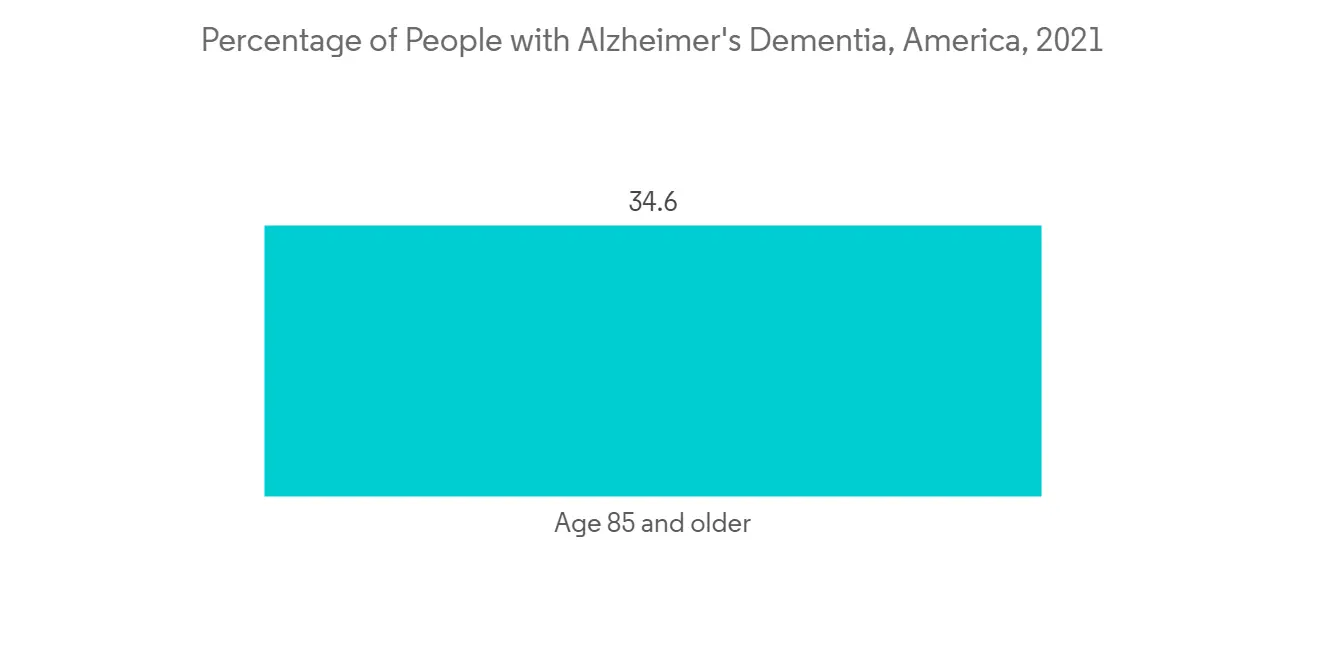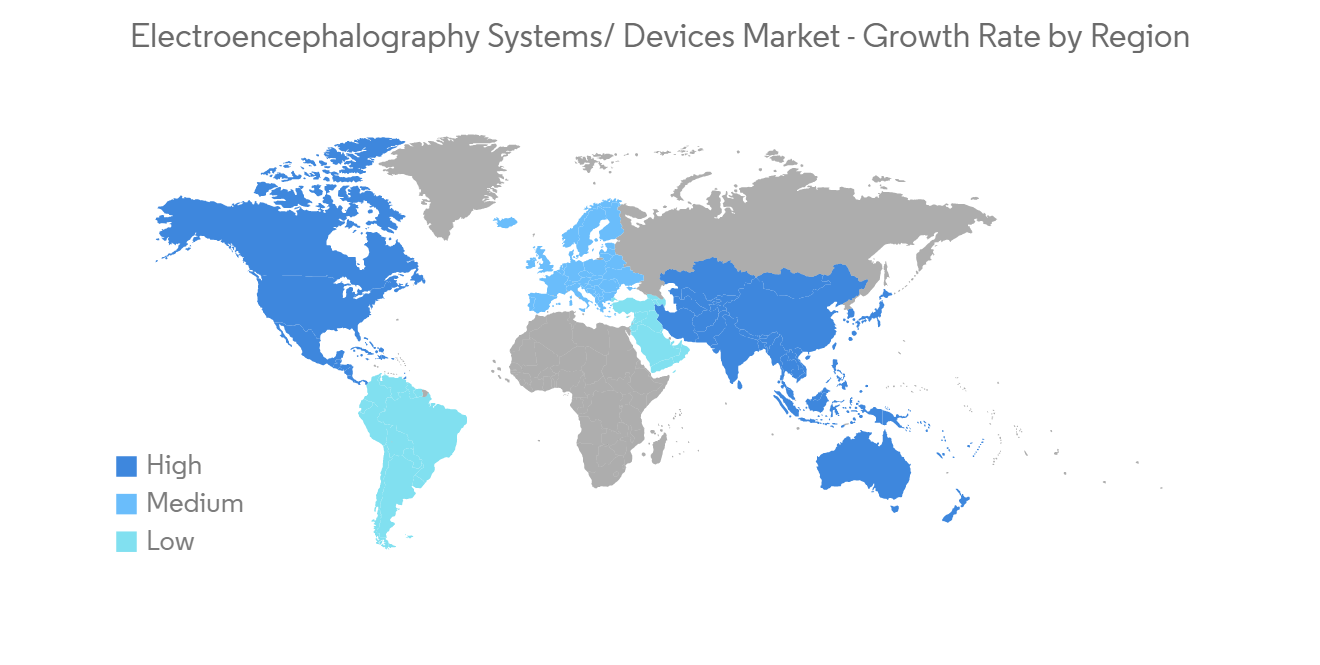 |
市場調查報告書
商品編碼
1273316
腦電圖測量系統/設備市場——增長、趨勢、COVID-19 的影響和預測 (2023-2028)Electroencephalography Systems/Devices Market - Growth, Trends, and Forecasts (2023 - 2028) |
||||||
※ 本網頁內容可能與最新版本有所差異。詳細情況請與我們聯繫。
在預測期內,腦電圖系統設備市場預計將以 8% 的複合年增長率註冊。
COVID-19 的情況要求對醫療服務進行重大重組,包括神經科服務。 根據 2021 年 1 月發表的論文“COVID-19 大流行對神經系統疾病患者的影響:迫切需要提高醫療保健系統的準備”,來自西班牙,尤其是馬德裡地區的數據顯示,95% 的醫院重新分配神經科醫生來幫助 COVID-19 患者,導致神經病房床位減少 89%。 大流行暴露了對神經系統疾病患者的護理不足,尤其是在已經缺乏醫院-社區整合的地方。 COVID-19 患者醫療保健資源的變化以及社會疏遠措施正在影響門診、住院和家庭護理環境中的神經康復。 然而,由於心髒病的增加,腦電圖系統的使用在全球範圍內顯著增加,市場現在正在獲得發展勢頭。
腦電圖是唯一可以確認阿爾茨海默病患者大腦活動並反映皮層神經元功能的臨床診斷儀器。 此外,阿爾茨海默氏症、多發性硬化症、癡呆症、帕金森病和中風的高發病率是採用這種腦電圖儀的主要驅動因素,進一步刺激了市場。 例如,根據帕金森基金會2020年3月更新的統計數據,到2020年,美國將有超過100萬人同時患有帕金森病,每年將有近6萬美國人被診斷出患有帕金森病,這一數字還在增加。 因此,由於全球神經系統疾病的高發病率,預計腦電圖系統/設備市場在預測期內將顯著增長。
此外,根據世界衛生組織(WHO)2021年10月公佈的數據,人口老齡化的速度比以往快得多,到2030年,全球六分之一的人將活到60歲。據報導,更 此時,60 歲及以上人口的比例將增加,到 2050 年幾乎翻一番,從 12% 增至 22%。 隨著人口老齡化導致健康問題,尤其是神經系統疾病的增加,預計住院人數也會增加。 這種住院將導致對腦電圖系統的需求,這有望推動腦電圖系統設備市場。
此外,增加產品發布和產品開發推動了市場增長。 例如,2022 年 8 月,Myneurva 推出了 Starrbase,這是一個用於其高級神經網絡分析 (ANNA) 的完全集成系統,包含 50 多個基於研究的大腦訓練項目。 此外,2022 年 2 月,Masimo 宣布美國食品和藥物管理局批准 SedLine 腦功能監測和 SedLine 兒科腦電圖傳感器用於兒科適應症。 這些因素可能會推動全球採用腦電圖系統/設備的需求。
但是,腦電圖系統的局限性預計會阻礙腦電圖系統/設備市場的增長。
EEG 測量系統/設備的市場趨勢
獨立的腦電圖系統未來有望實現健康成長
由於腫瘤、中風、腦癱等腦部相關疾病等神經系統疾病的增加,單機系統有望在未來得到健康發展。 這些受試者更有可能被這些系統常用的醫院收治。 獨立式是由硬件和軟件組成的固定在特定位置的系統,廣泛應用於醫院。 該系統使醫生和醫生能夠有效地解釋結果,重症監護的高覆蓋率正在推動該領域的增長。
阿爾茨海默病的發病率在不斷增加,預計在未來幾十年內還會繼續增加。 根據世界衛生組織 2021 年 9 月的報告,全球約有 5500 萬人患有癡呆症,每年報告的病例近 1000 萬例。 根據同一數據,阿爾茨海默氏癡呆症最為常見,約佔所有癡呆症的 60-70%。 因此,阿爾茨海默病的高發病率預計將在預測期內促進該行業的大幅增長。
此外,根據阿爾茨海默氏症協會 2021 年 3 月的報告,美國約有 620 萬 65 歲以上的人患有與阿爾茨海默氏症相關的癡呆症,到 2060 年這一數字將上升到 1380 萬。預計在人類中還會增加。 此外,根據同一消息來源,在 COVID-19 大流行期間,美國與阿爾茨海默氏症和癡呆症相關的死亡人數增加了 16%。 到 2021 年,阿爾茨海默病和其他癡呆症的事故成本將達到約 3550 億美元,到 2050 年,這一數額預計將超過 1.1 萬億美元。
因此,上述所有因素都有望在預測期內推動該細分市場的增長。

預計北美將佔據很大的市場份額
由於神經系統疾病的增加和睡眠障礙患病率的上升,預計北美將佔據全球腦電圖設備市場的很大份額。
根據世界衛生組織 (WHO) 和泛美衛生組織 (PAHO) 2020 年的調查,超過一半的北美國家 (60.7%) 部分或全部心理治療和諮詢服務、診斷和實驗室服務中斷28 個國家中有 11 個國家 (39.3%) 的衛生設施服務中斷。 研究表明,COVID-19 對整個美洲地區的精神、神經和物質使用 (MNS) 服務產生了重大影響。 然而,MNS 服務的類型及其中斷程度差異很大。 大多數國家的門診和社區服務(主要是家庭和日間護理服務)都受到了嚴重影響。
根據美國國家心理健康研究所 (NIMH) 2020 年版的數據,在特定年份,美國四分之一的成年人將患有可診斷的精神障礙,近 6% 的人將患有嚴重的殘疾。它估計有 報告稱,美國每年因嚴重精神疾病造成的總費用超過 3170 億美元。
此外,預計美國食品和藥物管理局批准的增加以及主要參與者推出的產品將提振市場。 例如,2021 年 11 月,Brain Scientific 宣布了一種先進的腦電圖 (EEG) 電極陣列,用於在需要 STAT EEG 記錄的常規臨床和研究環境中獲取快速腦電圖。下一代 NeuroCap EEG 已獲得美國食品和藥物管理局的批准耳機。
此外,不斷增長的醫療支出和完善的醫療基礎設施也顯著推動了該地區的整體市場增長。

腦電測量系統/設備行業概況
腦電圖系統/設備市場是一個分散且競爭激烈的市場,由幾家大型企業組成。 目前主導市場的公司包括 Natus Medical, Inc.、Cadwell Industries, Inc.、Medtronic 和 Nihon Kohden。
其他福利:
- Excel 格式的市場預測 (ME) 表
- 3 個月的分析師支持
內容
第一章介紹
- 調查假設和市場定義
- 本次調查的範圍
第二章研究方法論
第 3 章執行摘要
第四章市場動態
- 市場概覽
- 市場驅動力
- 研發費用增加
- 神經系統疾病的患病率增加
- 市場製約因素
- 腦電圖的局限性
- 波特的五力分析
- 新進入者的威脅
- 買方/消費者議價能力
- 供應商的議價能力
- 替代品的威脅
- 競爭公司之間的敵對關係
第 5 章市場細分
- 按類型
- 便攜式設備
- 獨立型
- 最終用戶
- 醫院
- 診斷中心
- 其他
- 按地區
- 北美
- 美國
- 加拿大
- 墨西哥
- 歐洲
- 德國
- 英國
- 法國
- 意大利
- 西班牙
- 其他歐洲
- 亞太地區
- 中國
- 日本
- 印度
- 澳大利亞
- 韓國
- 其他亞太地區
- 中東和非洲
- 海灣合作委員會
- 南非
- 其他中東和非洲地區
- 南美洲
- 巴西
- 阿根廷
- 其他南美洲
- 北美
第6章競爭格局
- 公司簡介
- Natus Medical, Inc.
- NeuroWave Systems, Inc
- Cadwell Industries, Inc.
- Medtronic
- Nihon Kohden Corporation
- Advanced Brain Monitoring, Inc.
- Cephalon A/S
- Compumedics Limited
- Fresenius SE & Co. KGaA
- General Electric Company(GE Healthcare)
- Koninklijke Philips N.V.(Philips Healthcare)
第7章 市場機會與將來動向
The electroencephalography systems devices market is expected to register a CAGR of 8% over the forecast period.
The COVID-19 situation necessitated significant rearranging of health services, including neurological services. According to an article published in January 2021 titled "The impact of the COVID-19 pandemic on people with neurological disorders: an urgent need to improve the health care system's preparedness," data from Spain, particularly the Madrid area, show that 95% of hospitals have re-allocated neurologists to assist COVID-19 patients, and the number of beds in neurology wards has been reduced by 89%. The pandemic has exposed the lack of sufficient health care for patients with neurological illnesses, particularly in locations where hospital-community integration is already lacking. The shift in health resources for COVID-19 patients, along with social distancing measures, has jeopardized neuro-rehabilitation in the outpatient context and inpatient and home care settings. However, the market is currently gaining traction due to the significant increase in the use of electroencephalography devices globally due to the increasing number of heart diseases.
Electroencephalography is the only clinical diagnostic instrument to see brain activity and reflect cortical neuronal functioning in Alzheimer's patients. Moreover, high incidences of Alzheimer's epilepsy, multiple sclerosis, dementia, Parkinson's disease, and stroke are the key driving factors for adopting this electroencephalography, further triggering the market. For instance, as per the Parkinson's Foundation Statistics updates from March 2020, more than one million people were living with Parkinson's disease in the United States by 2020, and nearly 60,000 Americans are diagnosed with Parkinson's disease every year. Thus, because of the high incidence of neurological disorders globally, the electroencephalography system/devices market is expected to grow significantly over the forecast period.
Moreover, the data published in October 2021 by World Health Organization (WHO) reported that the pace of population aging is much faster than in the past, and 1 in 6 people worldwide will be 60 years or over by 2030. At this time, the share of the population aged 60 years and over will increase and will nearly double from 12% to 22% by 2050. As the aging population creates an increase in health-related issues, especially neurological diseases, the hospitalization of patients is also expected to rise. This hospitalization is likely to lead to the requirement for electroencephalogram (EEG) systems, and this is expected to drive the electroencephalography systems devices market.
Moreover, increasing product launches and product development promotes market growth. For instance, in August 2022, Myneurva launched Starrbase, a fully integrated system of its Advanced Neural Network Analysis (ANNA), with over fifty research-based brain training programs. Moreover, in February 2022, Masimo announced the United States Food and Drug Administration clearance of pediatric indication for SedLine brain function monitoring and the SedLine pediatric EEG sensor. Such factors potentially drive the demand for adopting electroencephalography systems/devices worldwide.
However, the limitation of the electroencephalography system is expected to hamper the growth of the electroencephalography systems/devices market.
Electroencephalography Systems/Devices Market Trends
Standalone Electroencephalography System is Expected to Witness a Healthy Growth in Future
The standalone system is expected to witness healthy growth in the future owing to an increasing number of neurological disorders such as tumors, strokes, cerebral palsy, and other brain-related disorders. These target populations are more prone to admit to hospitals wherein these systems are commonly used. A standalone system is fixed at a particular place consisting of hardware and software and is widely used in hospitals. This system allows doctors and physicians to interpret the results efficiently and high application in critical care is boosting the segment growth.
The incidence of Alzheimer's has constantly been increasing, and it is expected to continue increasing in the coming decades. According to the September 2021 report of the World Health Organization, about 55 million people around the world are living with dementia, and nearly 10 million cases are reported every year. As per the same source, Alzheimer's is the most common form of dementia and constitutes about 60-70% of the total cases of dementia. Thus, the high incidence of Alzheimer's disease is expected to help in the significant growth of the segment over the forecast period.
Furthermore, according to the March 2021 report of the Alzheimer's Association, approximately 6.2 million people of age 65 years and more are living with Alzheimer's-related dementia in the United States, and it is projected that this number will increase to 13.8 million people by 2060. Further, as per the same source, Alzheimer's- and dementia-related deaths in the United States increased by 16% during the COVID-19 pandemic. It was estimated that in 2021, the country recorded about USD 355 billion in Alzheimer's and other dementia incurred costs, and it is expected that by 2050, this amount would rise to more than USD 1.1 trillion.
Thus, all aforementioned factors are expected to boost segment growth over the forecast period.

North America is Expected to Hold a Significant Share in the Market
North America is expected to hold a major market share in the global electroencephalography systems devices market due to increasing incidences of neurological disorders, and the rising prevalence of sleep disorders.
According to the World Health Organization's (WHO) and Pan American Health Organization's (PAHO) 2020 survey, psychotherapy and counseling services were partially or wholly disrupted in more than half of North American countries (60.7%), while diagnostic and laboratory services at mental health facilities were disrupted in 11 of 28 countries (39.3%). COVID-19 has had a considerable impact on mental, neurological, and substance use (MNS) services throughout the Region of the Americas, according to the survey. However, the types of MNS services and the extent to which they have been disrupted differ significantly. Outpatient and community-based services (mainly home and daycare services) were impacted considerably in most countries.
According to the United States National Institute of Mental Health (NIMH) 2020, it has been estimated that one in four American adults have a diagnosable mental disorder in any given year, and nearly 6% suffer from severe disabilities. The same source has also stated that the total cost of severe mental illness in the United States exceeds USD 317 billion per year.
Moreover, increasing approvals from the United States Food and Drug Administration and product launches by key players are expected to boost the market. For instance, in November 2021, Brain Scientific received the United States Food and Drug Administration clearance for the Next-Gen NeuroCap EEG Headset, an advanced Electroencephalogram (EEG) electrode array used to obtain rapid EEGs in routine clinical and research settings where the recording of STAT EEGs is desired.
Furthermore, increasing healthcare expenditure and the presence of well-established healthcare infrastructure are also fueling the growth of the overall regional market to a large extent.

Electroencephalography Systems/Devices Industry Overview
The Electroencephalography Systems Devices Market is fragmented and competitive, and consists of several major players. Some companies currently dominating the market are Natus Medical, Inc., Cadwell Industries, Inc., Medtronic, and Nihon Kohden Corporation.
Additional Benefits:
- The market estimate (ME) sheet in Excel format
- 3 months of analyst support
TABLE OF CONTENTS
1 INTRODUCTION
- 1.1 Study Assumptions and Market Definition
- 1.2 Scope of the Study
2 RESEARCH METHODOLOGY
3 EXECUTIVE SUMMARY
4 MARKET DYNAMICS
- 4.1 Market Overview
- 4.2 Market Drivers
- 4.2.1 Rising R&D Expenditure
- 4.2.2 Increasing Prevalence of Neurological Disorders
- 4.3 Market Restraints
- 4.3.1 Limitation of Electroencephalography System
- 4.4 Porter's Five Force Analysis
- 4.4.1 Threat of New Entrants
- 4.4.2 Bargaining Power of Buyers/Consumers
- 4.4.3 Bargaining Power of Suppliers
- 4.4.4 Threat of Substitute Products
- 4.4.5 Intensity of Competitive Rivalry
5 MARKET SEGMENTATION (Market Size by Value - USD million)
- 5.1 By Type
- 5.1.1 Portable Device
- 5.1.2 Standalone Device
- 5.2 By End User
- 5.2.1 Hospitals
- 5.2.2 Diagnostic Centers
- 5.2.3 Others
- 5.3 Geography
- 5.3.1 North America
- 5.3.1.1 United States
- 5.3.1.2 Canada
- 5.3.1.3 Mexico
- 5.3.2 Europe
- 5.3.2.1 Germany
- 5.3.2.2 United Kingdom
- 5.3.2.3 France
- 5.3.2.4 Italy
- 5.3.2.5 Spain
- 5.3.2.6 Rest of Europe
- 5.3.3 Asia-Pacific
- 5.3.3.1 China
- 5.3.3.2 Japan
- 5.3.3.3 India
- 5.3.3.4 Australia
- 5.3.3.5 South Korea
- 5.3.3.6 Rest of Asia-Pacific
- 5.3.4 Middle-East and Africa
- 5.3.4.1 GCC
- 5.3.4.2 South Africa
- 5.3.4.3 Rest of Middle-East and Africa
- 5.3.5 South America
- 5.3.5.1 Brazil
- 5.3.5.2 Argentina
- 5.3.5.3 Rest of South America
- 5.3.1 North America
6 COMPETITIVE LANDSCAPE
- 6.1 Company Profiles
- 6.1.1 Natus Medical, Inc.
- 6.1.2 NeuroWave Systems, Inc
- 6.1.3 Cadwell Industries, Inc.
- 6.1.4 Medtronic
- 6.1.5 Nihon Kohden Corporation
- 6.1.6 Advanced Brain Monitoring, Inc.
- 6.1.7 Cephalon A/S
- 6.1.8 Compumedics Limited
- 6.1.9 Fresenius SE & Co. KGaA
- 6.1.10 General Electric Company (GE Healthcare)
- 6.1.11 Koninklijke Philips N.V. (Philips Healthcare)













